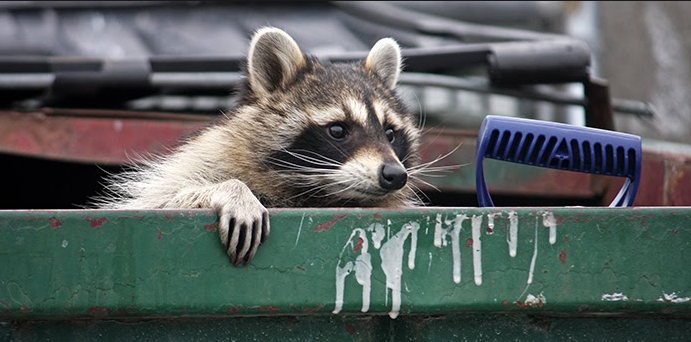If you’ve strolled through Toronto’s neighbourhoods, chances are you’ve spotted the unmistakable signs of raccoons at work. Knocked-over bins, scattered trash, and clawed-up garbage can lids are just some of the evidence left behind from their nighttime escapades.
These clever creatures are experts at navigating urban environments, turning backyards and alleyways into their playgrounds. For many residents, raccoons have become a quirky yet frustrating part of city life.
Their ability to thrive alongside humans has left homeowners scratching their heads, wondering how to protect their yards from these resourceful visitors. Whether it’s the persistent attempts to break into garbage bins or the chaos they leave in their wake, raccoons are a common yet challenging problem in Toronto. If you’re tired of waking up to a yard that looks like it’s been ransacked, you’re not alone, and there are steps you can take to outsmart these furry urbanites.
Why Are Raccoons Drawn to Urban Areas?
Urban spaces offer raccoons a buffet of food options and places to shelter. Garbage cans, in particular, are a prime target, often filled with leftovers, scraps, and sometimes even pet food. Here’s why raccoons keep coming back to these easy food sources:
- High-Calorie Meals: Garbage provides a dependable source of calorie-rich foods like oils, processed scraps, and proteins.
- Dexterous Paws: Raccoons can manipulate latches and pry open even some “raccoon-proof” lids.
- Adaptability: Unlike other wildlife, raccoons are comfortable navigating urban spaces, thriving despite the presence of humans.
Their ability to exploit human environments explains why raccoon encounters in Toronto are so common. However, the mess and odours left behind often lead to more significant concerns, such as attracting other wildlife or increasing the risk of contamination.
When Do Raccoons Cause the Most Trouble?
Raccoons are nocturnal, meaning their activities peak at night. While you may not see them, their evidence is often visible by morning. But their behaviour also changes with the seasons, and understanding this can help in managing encounters.
- Fall and Early Winter: This is a time of high activity as raccoons build fat reserves for the colder months. Their persistence in finding food is especially noticeable.
- Spring: Birth season begins in late February and extends into summer. Mothers become more active as they search for food for their young, increasing the likelihood of interactions.
- Winter: Although raccoons don’t hibernate, they do slow down during extreme cold, making them less active.
By knowing when raccoons are most active, you can time preventive measures effectively, reducing the chances of unwelcome visits.
Steps to Keep Raccoons Out
Preventing raccoons from invading your property takes consistency and the right approach. While it’s always best to rely on professionals like Skedaddle, here are key steps that can help make your home less attractive to wildlife:
Secure Food Sources
Garbage cans are the most common attractant for raccoons. Ensure all bins are housed in secure areas or use heavy-duty cans with locking lids. Additionally, other food sources should be minimized:
- Avoid leaving pet food outdoors overnight.
- Install baffles on bird feeders to prevent spillage.
- Maintain compost bins and ensure they’re properly sealed.
Eliminate Potential Shelter
Raccoons are not just looking for food; they also seek warm, secluded spots to make their dens. To protect your home from being their nesting ground, consider the following steps:
- Trim tree branches that hang close to rooftops.
- Seal potential entry points like vents, chimneys, and gaps in your siding.
- Repair structural issues, such as rotting wood or missing shingles, that could provide access.
Keep Your Yard Clean
Smells can attract raccoons, so maintaining a clean outdoor space is essential. Dispose of old food containers and other odour-producing items promptly. Tidying up your yard sends a clear signal that food and shelter are off-limits.
Trust the Professionals for Long-Term Solutions
If raccoons have already settled on your property, calling in the experts is the safest and most effective course of action. At Skedaddle Humane Wildlife Control, we’ve spent over 30 years providing solutions that go beyond removal.
Our Comprehensive Process
We start with a detailed property assessment to find all entry points and vulnerabilities. From there, we use humane removal strategies that prioritize both your safety and that of the animals. For example, during birthing season, we carefully extract baby raccoons and reunite them with their mothers outside your home.
Once the removal is complete, we seal entry points using durable materials to prevent future invasions. Our services don’t stop there—we also clean and deodorize affected areas to eliminate odours that might attract more wildlife.
Why Choose Skedaddle
Here’s why Skedaddle is the go-to for wildlife control in Toronto:
- Over 30 Years of Experience: We’ve perfected humane, long-lasting solutions for handling raccoon conflicts.
- Detailed Preventive Measures: Beyond removal, we ensure your property is protected against future issues.
- Thorough Cleanup: We restore affected areas, leaving your home clean, odour-free, and wildlife-proof.
With Skedaddle, you can trust that your home is in expert hands, providing peace of mind and a safe, wildlife-free space for you and your family.
Take Control of Your Property Today
Dealing with raccoons in your garbage or home is more than just an inconvenience; it’s a sign that intervention is needed. While securing food sources and sealing your home can help deter wildlife, professional assistance ensures long-term results.
At Skedaddle, we combine expertise with humane methods to give Toronto homeowners peace of mind. Contact us today to schedule an assessment and take the first step toward reclaiming your home. Together, we’ll keep unwelcome wildlife at bay and ensure your property stays safe and secure.



